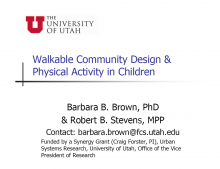We are pleased to announce an exciting new alliance between Active Living Research and GP RED to co-host and coordinate...
Walkable Community Design & Physical Activity in Children

Presentation at the 2010 Active Living Research Annual Conference
Background:
The number of children who walk to school has declined precipitously in recent decades but new community designs that emphasize walkability may be able to reverse these declines. This study examines Daybreak Utah, planned by a new urbanist team and designated as a LEED-ND (Leadership in Energy and Environmental Design-Neighborhood Development) pilot community. New urbanist designs include walkability features such as density, diverse destinations, sidewalks and walking paths, front porches, and narrow streets with calmed traffic. LEED-ND pilots offer both energy efficiency and pedestrian-friendliness qualities. Both design emphases should facilitate walks to school and perhaps at other times, although most prior studies of community walkability have examined adults and no studies have focused on LEED-ND pilot communities.
Objectives:
We compare moderate to vigorous physical activity (MVPA) levels for particular time periods across three groups of fifth graders: the “Walkable” community of Daybreak; the “Mixed” community students attend Daybreak’s school but live in a standard suburban community just outside its boundaries; the “Less walkable” community students live in an adjacent standard suburban community and attend a less walkable school. The less walkable school also adopted a special 15-minute track time from 10:00 to 10:15 every day, in addition to required physical activity times.
We test the following questions:
1) Do MVPA minutes of boys and girls in the three communities differ for time periods in the community (commute to and from school, weekday after school/evenings, and weekends)?
2) Does the extra track time in the less walkable school help elevate MVPA?
3) Do MVPA minutes of boys and girls differ for walkable and mixed community boys during school and on weekends (suggesting the presence of selection effects)?
Methods:
Accelerometers measured moderate-to-vigorous physical activity (MVPA) among 5th graders and parental surveys tapped two sociodemographic control variables (parent education and number of rooms in the home) and an attitudinal control for potential selection effects (“Ideally my child would walk to school,” measured with a 4-point agreement scale). Students reported their usual mode of travel to school. Accelerometer data files (n = 211) were screened to assure valid hours (>= 30 minutes of accelerometer counts per hour) and days (>= 4 hours of valid data per day; >= 2 valid weekdays for weekday analyses; >= 1 valid weekend day for weekend analyses). Screening and accelerometer malfunctions reduced sample size to 203; missing parental surveys reduced sample size to 185 for week days; many children did not wear the accelerometer on weekends, reducing weekend samples size to 149.
Results:
Among the three groups of students, 86% of walkable community students, 46% of mixed community students, and 19% of less walkable community students reported walking to/from school (> or = 1 time) in a typical week. Community (Walkable, mixed, less walkable) by gender analyses of covariance demonstrated that community walkability related to more MVPA during travel times to school (p < .05) and from school (p < .01) and, among boys only, during weekday after school and evening time periods (p < .05). In several time periods (going to school, after school/evening, weekend, lunch at school, other times at school, all p < .05) boys were more active than girls, but the MVPA gender gap closed during the travel from school time and during the special track time adopted by the non-walkable school. The extra track time elevated MVPA during that time period (p < .01), but not sufficiently to create higher MVPA across the school day. Students in the same (walkable) school from the mixed and walkable communities had similar in-school MVPA levels and all groups had similar weekend MVPA, providing little evidence of selection effects.
Conclusions:
In the combined half hours before and after school, walkable community boys achieved about 5 more minutes of MVPA and girls achieved about 6 more minutes of MVPA than students from the less walkable community. These amounts are comparable to other studies that contrast walkers and non-walkers but involve the more challenging test of community differences. In addition, during the weekday after school and evening times, boys from the walkable community accrued over 10 minutes of MVPA more than all other groups. Boys were more active than girls in all time periods except for the walk to school and during a special track time adopted by the non-walkable school. Based on these results, a walkable community design and an extra school-based activity opportunity are both recommended to increase MVPA, especially given their ability to reduce the gender gap in MVPA. Walkable community designs also provide other benefits, such as a reduction in air pollution and an overall healthier environment, suggesting multiple reasons to adopt walkability zoning and development policies.
Support:
Synergy seed grant (2006) for interdisciplinary urban systems research from the Office of the Vice President for Research at the University of Utah.
STAY UP TO DATE
RECENTLY ADDED TOOLS & RESOURCES
MOVE! A BLOG ABOUT ACTIVE LIVING
The "Active Living Conference" aims to break down research and practice silos and...







